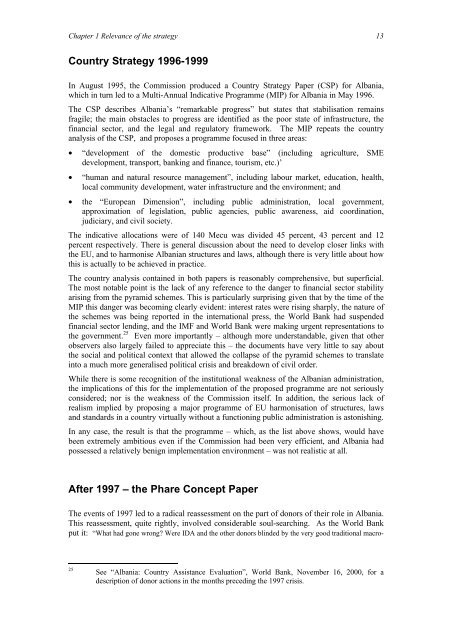Final Report - European Commission - Europa
Final Report - European Commission - Europa
Final Report - European Commission - Europa
You also want an ePaper? Increase the reach of your titles
YUMPU automatically turns print PDFs into web optimized ePapers that Google loves.
Chapter 1 Relevance of the strategy 13<br />
Country Strategy 1996-1999<br />
In August 1995, the <strong>Commission</strong> produced a Country Strategy Paper (CSP) for Albania,<br />
which in turn led to a Multi-Annual Indicative Programme (MIP) for Albania in May 1996.<br />
The CSP describes Albania’s “remarkable progress” but states that stabilisation remains<br />
fragile; the main obstacles to progress are identified as the poor state of infrastructure, the<br />
financial sector, and the legal and regulatory framework. The MIP repeats the country<br />
analysis of the CSP, and proposes a programme focused in three areas:<br />
• “development of the domestic productive base” (including agriculture, SME<br />
development, transport, banking and finance, tourism, etc.)’<br />
• “human and natural resource management”, including labour market, education, health,<br />
local community development, water infrastructure and the environment; and<br />
• the “<strong>European</strong> Dimension”, including public administration, local government,<br />
approximation of legislation, public agencies, public awareness, aid coordination,<br />
judiciary, and civil society.<br />
The indicative allocations were of 140 Mecu was divided 45 percent, 43 percent and 12<br />
percent respectively. There is general discussion about the need to develop closer links with<br />
the EU, and to harmonise Albanian structures and laws, although there is very little about how<br />
this is actually to be achieved in practice.<br />
The country analysis contained in both papers is reasonably comprehensive, but superficial.<br />
The most notable point is the lack of any reference to the danger to financial sector stability<br />
arising from the pyramid schemes. This is particularly surprising given that by the time of the<br />
MIP this danger was becoming clearly evident: interest rates were rising sharply, the nature of<br />
the schemes was being reported in the international press, the World Bank had suspended<br />
financial sector lending, and the IMF and World Bank were making urgent representations to<br />
the government. 25 Even more importantly – although more understandable, given that other<br />
observers also largely failed to appreciate this – the documents have very little to say about<br />
the social and political context that allowed the collapse of the pyramid schemes to translate<br />
into a much more generalised political crisis and breakdown of civil order.<br />
While there is some recognition of the institutional weakness of the Albanian administration,<br />
the implications of this for the implementation of the proposed programme are not seriously<br />
considered; nor is the weakness of the <strong>Commission</strong> itself. In addition, the serious lack of<br />
realism implied by proposing a major programme of EU harmonisation of structures, laws<br />
and standards in a country virtually without a functioning public administration is astonishing.<br />
In any case, the result is that the programme – which, as the list above shows, would have<br />
been extremely ambitious even if the <strong>Commission</strong> had been very efficient, and Albania had<br />
possessed a relatively benign implementation environment – was not realistic at all.<br />
After 1997 – the Phare Concept Paper<br />
The events of 1997 led to a radical reassessment on the part of donors of their role in Albania.<br />
This reassessment, quite rightly, involved considerable soul-searching. As the World Bank<br />
put it: “What had gone wrong? Were IDA and the other donors blinded by the very good traditional macro-<br />
25<br />
See “Albania: Country Assistance Evaluation”, World Bank, November 16, 2000, for a<br />
description of donor actions in the months preceding the 1997 crisis.
















